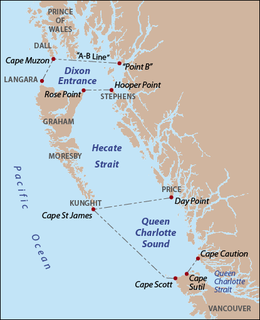Slingsby Channel is a strait on the north side of Bramham Island in the Queen Charlotte Strait region of the Central Coast of British Columbia. [1] It is one of only two entrances to Seymour Inlet and the associated maze of waterways inland, which lie to the northeast of Bramham. The other entrance is Schooner Channel, formerly Schooner Passage, on the east side of that island.

A strait is a naturally formed, narrow, typically navigable waterway that connects two larger bodies of water. Most commonly it is a channel of water that lies between two land masses. Some straits are not navigable, for example because they are too shallow, or because of an unnavigable reef or archipelago.
Bramham Island is an island in the Queen Charlotte Strait region of the Central Coast of British Columbia, Canada, located on the north side of the entrance to that strait. It lies in the entrance to the maze of waterways inland to the northeast, focussed on Seymour Inlet, which includes Belize Inlet and Allison Harbour and Nugent Sound, though it is flanked only by Slingsby Channel, on its north, and by Schooner Channel on its east. To its west are the open waters at the convergence of Queen Charlotte Sound and Queen Charlotte Strait. The island is approximately 23 km2 in size and is mostly low-lying hills and includes a number of freshwater lakes.

Queen Charlotte Strait is a strait between Vancouver Island and the Mainland of British Columbia, Canada. It connects Queen Charlotte Sound with Johnstone Strait and Discovery Passage and via them to the Strait of Georgia and Puget Sound. It forms part of the Inside Passage from Washington to Alaska. The term Queen Charlotte Strait is also used to refer to the general region and its many communities, notably of the Kwakwaka'wakw peoples. Despite its name, Queen Charlotte Strait does not lie between Haida Gwaii and the mainland; that body of water is named Hecate Strait.
The Fox Islands, which lie in its entrance, Bramham Island and the channel itself, plus Slingsby Rock and Slingsby Point, are named in association with Bramham Park, the Yorkshire home of George Lane-Fox. [2]
The Fox Islands are a small group of islands in the entrance to Slingsby Channel in the Queen Charlotte Strait region of the Central Coast region of British Columbia, Canada. Slingsby Channel lies along the north flank of Bramham Island and is one of only two waterways connecting to Seymour Inlet and its side-inlets, which form a maze of inlets within the nearby mainland; the other, on the east side of Bramham, is Schooner Channel.

Bramham Park is a Grade I listed 18th-century country house in Bramham, between Leeds and Wetherby, in West Yorkshire, England.

Yorkshire, formally known as the County of York, is a historic county of Northern England and the largest in the United Kingdom. Due to its great size in comparison to other English counties, functions have been undertaken over time by its subdivisions, which have also been subject to periodic reform. Throughout these changes, Yorkshire has continued to be recognised as a geographical territory and cultural region. The name is familiar and well understood across the United Kingdom and is in common use in the media and the military, and also features in the titles of current areas of civil administration such as North Yorkshire, South Yorkshire, West Yorkshire and East Riding of Yorkshire.
Through the Slingsby Channel flows the world's strongest current, the Nakwakto Rapids, that has been measured at speeds up to 18.4 miles per hour. [3] The current is so fast at times, that people have tied a rope to Turret Rock, which is located right in the middle of the rapids, and then water-skied. [4]




